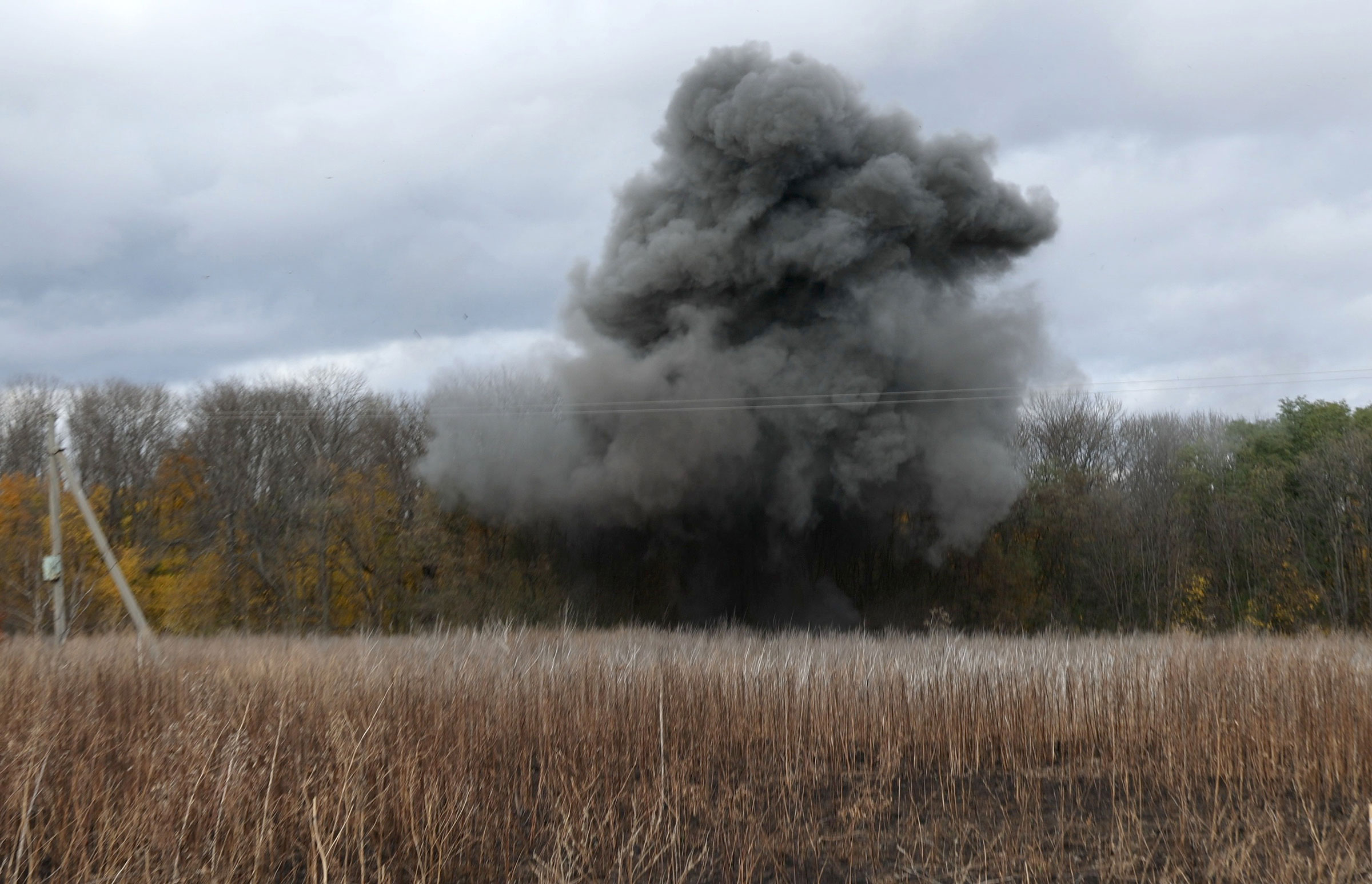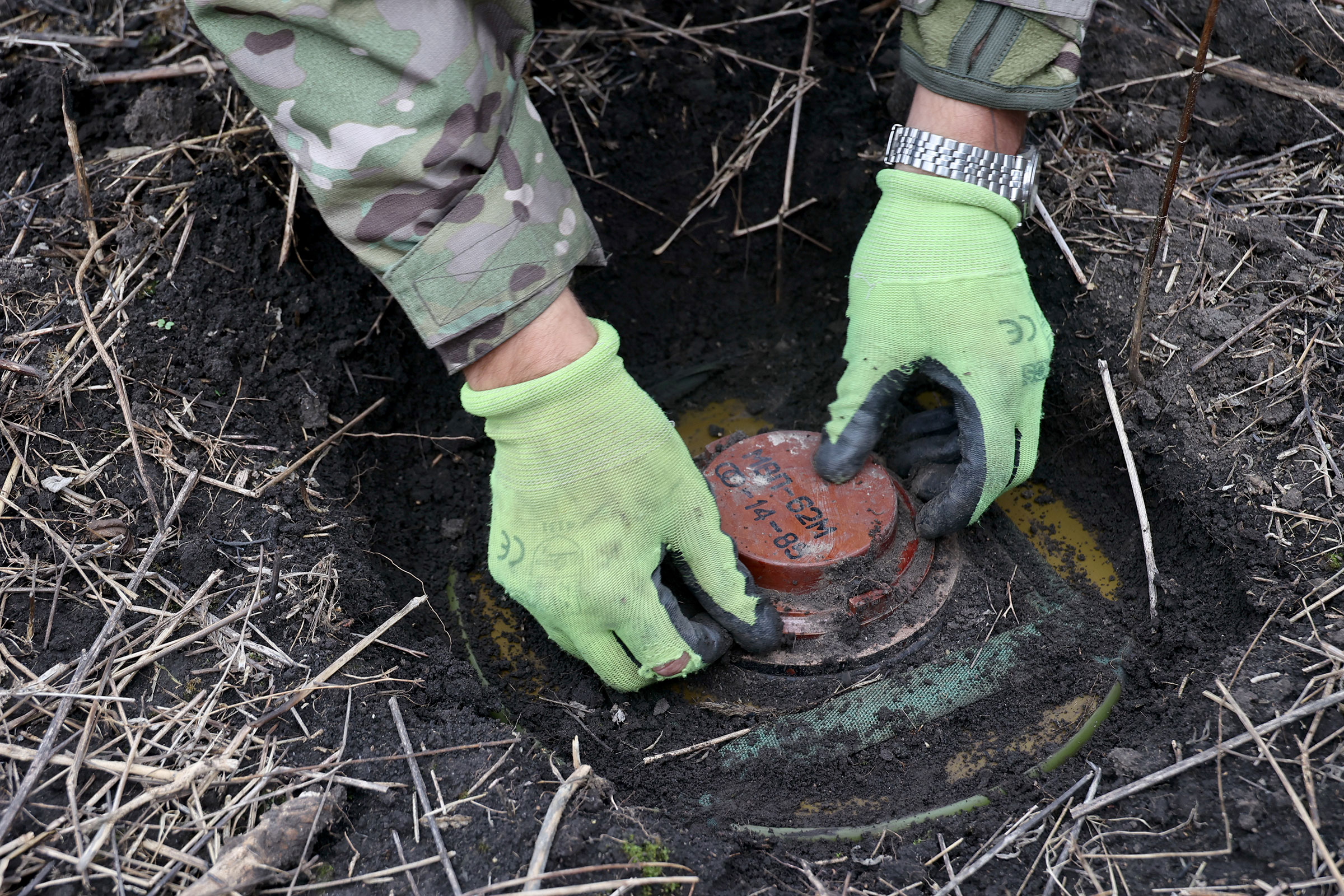VERA BERGENGRUEN

On the top floor of Kyiv's Cabinet of Ministers building, Ukrainian Economy Minister Yulia Svyrydenko and two advisers huddle around a laptop. A map of the country is on the screen, overlaid with a honeycomb pattern of hexagonal tiles, ranging from pale yellow to blood red. As the group types questions into a chatbot, filtering for areas close to schools or power lines, the model zooms into the satellite imagery until a field with individual trees becomes visible. A red bubble with an exclamation point marks a suspected landmine. A staffer clicks a button, creating a request to dispatch a demining team to clear it.
More than 600 days since Russia's invasion, Ukraine has surpassed Afghanistan and Syria to become the most heavily mined country on earth. A staggering one-third of its territory is thought to be littered with millions of unexploded mines and cluster bombs, as well as trip wires, booby traps, and shell fragments. The vast minefields have not only bogged down Ukraine’s military counteroffensive. They've endangered six million civilians and rendered parts of the nation's most valuable farmland unusable, impacting both Ukraine's economy and the global food supply.
"The scale of the contamination of Ukraine with mines and unexploded ordnance is the largest since the Second World War," Svyrydenko tells TIME. It would take Ukraine 757 years to undo the damage using conventional methods and their current resources, according to an estimate published by GLOBSEC, a think tank based in Slovakia, which called the outlook "little short of terrifying in terms of the scope of work that lies ahead."
As of Nov. 1, at least 264 civilians had been killed by mines, and more than 830 have been maimed or injured since Russia's invasion, according to figures shared with TIME by Ukraine's Economy Ministry, numbers that do not account for territories still under Russian occupation or experiencing heavy fighting. Officials say the number of landmine victims could reach 9,000 by 2030 if the problem isn't effectively addressed. In addition, "Without demining, we will not be able to fully launch our economy,” says Svyrydenko.

Servicemen examine the territory with the help of a drone during a press tour to demonstrate the integration of AI into the process of humanitarian demining, in the Zhytomyr Region, northern Ukraine, on Sept. 20, 2023.
Svyrydenko, 37, is in no mood to wait. She has outlined a vision to bring 80% of contaminated land back into economic use within 10 years. To do so, Ukraine intends to leverage all the tech tools at its disposal—from sophisticated AI-driven impact assessments to homemade mine-detecting drones—to accelerate what has traditionally been a slow, labor-intensive clearing process. The government has partnered with U.S. data analytics giant Palantir to combine dozens of previously siloed data streams and develop models that will determine which mine clearances will have the biggest impact. They've also harnessed the tech talent of college-age Ukrainian programmers, who developed mine-reporting apps and participated in hackathons, as well as innovative farmers who repurposed their tractors into demining machines.
More From TIME
The project to demine Ukraine will be a massive one that will unfold over years. The World Bank estimates the cost could exceed $37 billion. But demining officials and international experts say that the demining processes being pioneered in Ukraine are likely to forever change the speed, efficiency and safety of clearing war zones in the aftermath of global conflicts.
"I've probably worked in nearly every mine-affected country in the last 30 years, and this is the combination of all previous countries’ experience with the Ukrainian love of innovation and technology,” says Paul Heslop, head of U.N. Mine Action at the United Nations Development Programme in Ukraine. "We're going to see a fundamental change in the way that humanitarian demining is done in the next three years in Ukraine that will affect mine action the whole world over.”
The humanitarian process used to detect and clear unexploded land mines has changed little since World War II. Until recently, Ukraine had no unified database that kept track of surveyed terrain or aggregated information from commercial, international, and government operators, Ukrainian officials told TIME. Decisions were made based on a predetermined priority list and often outdated surveys that in some cities and villages were processed on paper, Svyrydenko says.
Given the vast number of mines over an estimated 67,000 sq. mi. of contaminated land, the main question confronting the Ukrainians was how to prioritize the work. Much of the area suspected of being mined by the Russians likely does not have any hazards, says Heslop, the head of U.N. Mine Action in Ukraine. But "if only 1% of that land is actually contaminated, that's still 10 times as much land as is contaminated in Afghanistan," he adds. Deciding where to best deploy scant resources could mean the difference between resolving the problem in years or letting it drag on for decades.
Ukrainian officials decided to focus on clearing land with a high economic output, cutting down the driving times to hospitals, restoring power, and rebuilding bridges and schools where real-time data showed it would impact the most people. They are experimenting with ways to use precise satellite imagery and AI-enabled algorithms to more quickly release land if there is no evidence of mines. "We wanted a data-driven approach to make decisions when it came to demining," says Anton Bets, the Economy Ministry's digitization advisor, spinning around the laptop to show the new platform. "This was an idea half a year ago. Now, this is a real product."

A plume of smoke rises after a controlled explosion as a consolidated squad of the Explosives Service of Ukraine carries out demining work in Kharkiv Region, on Oct. 23, 2023
Palantir, which has been working with Ukraine's government since June 2022, signed a series of agreements in May to provide its data-analytics software to various Ukrainian agencies. They worked together to develop a platform that combined data from government agencies, including the Ministries of Education, Defense, Agriculture, Energy, and Infrastructure, with information like cell phone data from Ukrainian mobile operators, which can reveal how many people are actually living in an area or using certain roads.
So far, the platform has integrated 82 data sets, according to Palantir, and connected 6 million buildings, 60,000 train segments, and one million road segments. A demo TIME viewed depicts the data in color-coded layers: transmission lines are shown in colors ranging from blue to red depending on their voltage; another filter shows whether territory is occupied or liberated; and others note the locations of nearby power plants or schools. Satellite imagery can show whether the land is in use, or if there have been any recent explosions. A dashboard tallies the number of fatalities, the confirmed and suspected hazards, the number of buildings affected, and the square meters of hazardous area. A ticker at the bottom collects news articles and other reports.
"Usually we'd be talking decades, if not centuries, to demine in a conventional way," says Ishraq Irteza, an engineer working on the project at Palantir's London office. "The ability to take this cohesive picture of what's actually happening on the ground is so central to their ability to reduce that number.”
The platform uses Palantir’s AIP, a platform that connects large-language models to datasets, as a kind of virtual assistant in the style of ChatGPT to provide real-time data, automatically provide officials with the best options, schedule demining requests, and customize alerts. In theory, this allows officials to prioritize clearing mines that will impact the most people or have the biggest economic effect. "It means that everybody's making decisions based on the full remit of information," Irteza explains, "rather than some very aggregated number that someone's made up from some model in an Excel sheet from five years ago."

A sapper defuses an anti-tank mine as a consolidated squad of the Explosives Service of Ukraine carries out demining work in Kharkiv Region, on Oct. 24, 2023.
Beneath the layers of data, the actual demining process still relies on humans and hardware on the ground.
The sheer volume of requests to clear territory liberated from the Russians has overwhelmed Ukraine’s state emergency service and international partners. A significant portion of Ukraine's agricultural land remains too dangerous to farm. In some regions, increasingly desperate farmers took matters into their own hands during the spring planting season earlier this year. Many repurposed farm equipment and hobbyist metal detectors to attempt to clear their fields on their own. Others resorted to so-called "dark deminers," contractors who charged cheap prices to clear the land using primitive equipment, with no way to certify whether it was subsequently safe to use. This led to dozens of casualties in farming communities in April and May, Ukrainian officials told TIME. In announcements posted on Telegram channels, authorities appealed to farmers: "Do not put your own lives in danger!"
Pete Smith, the Ukraine program manager for HALO Trust, an international nonprofit that clears landmines and has more than 1,000 staff on the ground in the country, says Ukraine is the first country he can recall that has done this level of humanitarian demining work while the conflict is still ongoing. Ukraine's focus on collecting all the data in one place, combined with drone footage and surveys from its partners, "can show us where contamination is, but equally powerfully it tells us where contamination is not," Smith says, which can then be shown to affected communities.
"There is no silver bullet in mine action; clearance is expensive and resource-intensive," he adds. "But if we're going to do this quickly, it's just as much about not just clearing the mines, but about using [this data] to gain the confidence of the communities so they can see how great swathes of their land can be put into productive use very quickly."

Ukrainian military sappers demine the road in a fog close to Kherson, Ukraine, on Feb. 3, 2023.
Ukraine currently has 29 demining machines and 3,000 specialists, according to the Ministry of Economy. (One UN official told TIME it would take up to 20,000 deminers working in Ukraine to make a significant difference by 2025.) Even as the data available has vastly improved the targeting of mines, the slow pace of procuring new equipment has frustrated officials.
Inspired by World War II-era tanks, some Ukrainian engineers have been adapting farm excavators, using their spinning metal chains to root out any unexploded mines. In August, after a year of testing, officials also certified the first Ukrainian-made demining machine, manufactured in Kharkiv, which they say will be able to handle 95% of antitank and antipersonnel mines. "The equipment is easy to use and maintain, as well as significantly cheaper than foreign analogues," Oleg Synegubov, the head of the Kharkiv regional state administration, posted on Telegram on Oct. 27. The cost of one machine is UAH 5.6 million, or $154,200—less than one-third of the cost of the first machine Ukraine received from abroad last year, the British-made Armtrac 400.
Ukraine’s Digital Ministry also recently unveiled an unmanned aerial mine detector that it says can operate four times faster than humans. The new drone uses a combination of thermal, hyperspectral, and magnetometer sensors to detect mines from a low altitude and transmit that information back to sappers operating from a secure location. This will “significantly speed up the process of demining Ukrainian territories and make it safer," Ukraine's Minister of Digital Transformation Mykhailo Fedorov said on Telegram Oct. 27.
Svyrydenko says she expects the government's official demining strategy will be fully adopted by the end of the year. As with much of the country’s wartime tech, she believes Ukraine's demining syststem will set a new international standard. “We are fully changing the approach, especially when it comes to using big data,” says Svyrydenko. “We have the opportunity to improve the existing technology, and it will be something new that Ukraine can export in the future.”
No comments:
Post a Comment